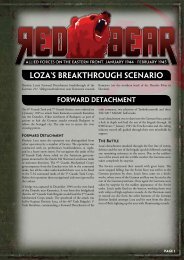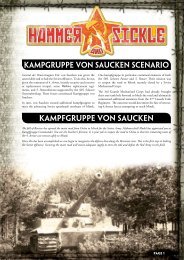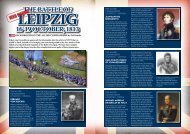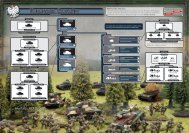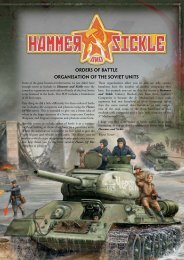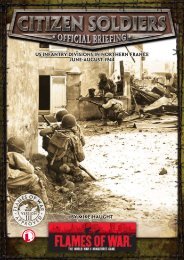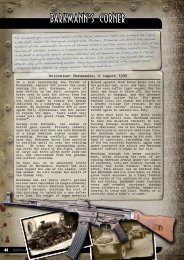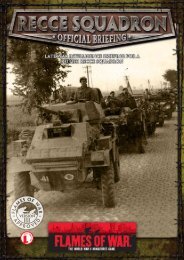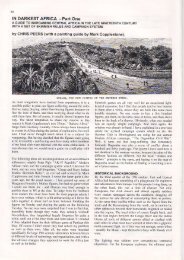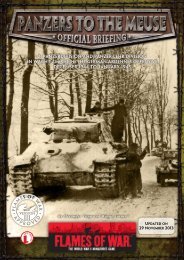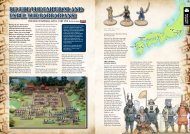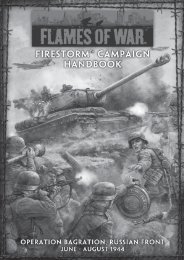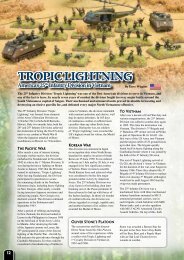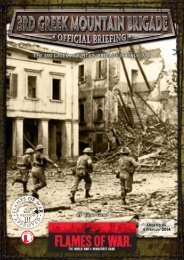Create successful ePaper yourself
Turn your PDF publications into a flip-book with our unique Google optimized e-Paper software.
The numerous smaller actions fought<br />
in the aftermath <strong>of</strong> the collapse <strong>of</strong> the<br />
main line would make ideal skirmish<br />
scenarios. Small parties conducting<br />
desperate rearguard actions are simple<br />
to play out, but perhaps <strong>of</strong> more interest<br />
to the wargamer are the attempts by<br />
small, mixed and probably wounded<br />
groups to steal away through the walled<br />
enclosures and gardens <strong>of</strong> the village <strong>of</strong><br />
Khig. Perhaps the 66th’s mascot Bobby<br />
could even take part in these actions.<br />
This could take the form <strong>of</strong> a “cat and<br />
mouse” chase through the alleyways<br />
and buildings, not unlike a 19th Century<br />
version <strong>of</strong> the Battle <strong>of</strong> Mogadishu over<br />
a hundred years later!<br />
Gaming the Battle<br />
<strong>of</strong> Kandahar<br />
An interesting way to represent the<br />
Battle <strong>of</strong> Kandahar would be to position<br />
three or four small villages along the<br />
central length <strong>of</strong> a long table, and have<br />
the Afghan player secretly split his<br />
force between the defence <strong>of</strong> each. The<br />
British must fight their way up this line,<br />
winning the game by reaching the last<br />
position.<br />
As a skirmish game, the players or<br />
referee could invent a suitably thrilling<br />
climax to the war (especially if they<br />
have fought this series <strong>of</strong> games as a<br />
linked campaign). Though Ayub Khan<br />
escaped, and lived for another 35<br />
years, perhaps a small force could be<br />
dispatched in an attempt to capture him<br />
and his <strong>of</strong>ficers before they quit the field<br />
and cause more trouble for the British!<br />
Perhaps defended by an elite bodyguard,<br />
Ayub Khan must escape, while a small<br />
force <strong>of</strong> British and Indians seek to<br />
locate and capture him.<br />
Miniatures<br />
Players should have little or no trouble<br />
finding suitable miniatures for use in<br />
the battles <strong>of</strong> the Second Afghan <strong>War</strong>.<br />
Foundry produce several excellent<br />
ranges, including a selection <strong>of</strong> very<br />
characterful miniatures designed<br />
especially for the period and featuring<br />
oddities such as the Amir’s Highland<br />
Guard and a British <strong>of</strong>ficer wearing an<br />
Indian sheepskin pashteen to keep the<br />
cold weather at bay. For those wishing<br />
to collect a larger force <strong>of</strong> British,<br />
<strong>War</strong>games Factory’s British Firing<br />
Line set is ideal (Rorke’s Drift took<br />
place at the beginning <strong>of</strong> the second year<br />
<strong>of</strong> the war).<br />
For those more inclined to the skirmish<br />
scale, Foundry’s Darkest Africa<br />
range provides plenty <strong>of</strong> characterful<br />
miniatures, as do Askari Miniatures.<br />
British Forces in the<br />
Second Afghan <strong>War</strong><br />
The British fielded a wide range <strong>of</strong><br />
units in the Second Afghan <strong>War</strong>, with<br />
regiments coming from Britain and<br />
all over India. Scottish Highlanders<br />
fought alongside Nepalese Ghurkhas,<br />
Rifle regiments beside Punjabis, and<br />
Foot Regiments from the Midlands<br />
beside those from Baluchistan.<br />
Likewise, cavalry was drawn from an<br />
equally diverse range, and most <strong>of</strong> the<br />
thirteen or so brigades that made up<br />
the three field forces mixed battalions<br />
and regiments so that one European<br />
unit served in the same formation as<br />
two or sometimes three from India.<br />
Such a mixed force is a dream for<br />
most wargamers, whatever level they<br />
are playing at, from battalion-level<br />
confrontations right down to skirmishes.<br />
Afghan Forces<br />
The Afghans were split into two main<br />
groups – the regulars and the tribesmen.<br />
The regular Afghan army had been<br />
armed and equipped by the British in<br />
the aftermath <strong>of</strong> the First Afghan <strong>War</strong>,<br />
and in some cases actually carried old<br />
British weapons and wore elements <strong>of</strong><br />
worn out uniform. In addition, some<br />
elements <strong>of</strong> the regular army were very<br />
well equipped indeed, especially that<br />
which faced Burrows at the Battle <strong>of</strong><br />
Maiwand. Of particular interest to many<br />
wargamers are the Amir’s ‘Highland<br />
Guard,’ a unit styled after Britain’s<br />
Highlander regiments, complete with<br />
kilts, red coats and pith helmets.<br />
On the other hand, the Afghans <strong>of</strong>ten<br />
fielded large numbers <strong>of</strong> tribesmen,<br />
sometimes alongside the regulars, but,<br />
particularly in the last few battles <strong>of</strong><br />
the war, on their own. These carried the<br />
infamous jezail, as well as numerous<br />
weapons looted from the baggage trains<br />
<strong>of</strong> their enemies, and wore a wide range<br />
<strong>of</strong> non-uniformed, traditional dress.<br />
Uniforms<br />
The Second Afghan <strong>War</strong> represents<br />
an interesting period for the collector<br />
<strong>of</strong> British colonial forces, because it<br />
took place right on the cusp <strong>of</strong> the<br />
changeover from red coats to khaki.<br />
Contemporary paintings show both in<br />
use, and it is likely that both were worn<br />
by different units in the same field force.<br />
Often, the heavier red coats were worn<br />
in cold weather, and the lighter khaki<br />
dress in the heat <strong>of</strong> summer. As the<br />
battles <strong>of</strong> the war were fought in both<br />
the depths <strong>of</strong> winter and the height <strong>of</strong><br />
summer, players can (and should)<br />
use either.<br />
For details <strong>of</strong> both British and Afghan<br />
uniforms, Osprey’s MAA72 – The North<br />
West Frontier is a great resource.



